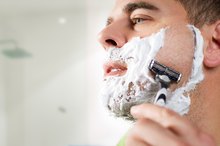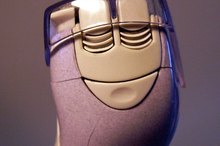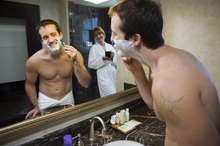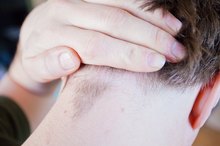How to Get Rid of Ingrown Hair on the Bottom of a Scrotum
Ingrown hairs occur when individual hairs grow at a slant, usually a result of improper shaving technique. Although more common in women who shave their bikini line, ingrown hairs can form on the underside of men's scrotum as well. Men who opt for a hair-free genital appearance can suffer from the pain and irritation that go with ingrown hairs. Treating this problem requires close examination of the scrotum to locate the problematic hair and successfully eliminate it.
Apply a warm compress to the bottom of the scrotum to soften the hair and open hair follicles. Do this two or three times a day for up to two minutes each time, until you are prepared to remove the ingrown hair. A warm compress will help relieve swelling and pain while prepping the skin for ingrown hair removal.
How to Dislodge Deep Ingrown Underarm Hair
Learn More
Cleanse the scrotum surrounding the ingrown hair with a mild soap and soft washcloth 2. Rubbing the cloth in a circular motion may loosen your ingrown hair, coaxing it out of the follicle. Alternatively, a soft-bristled toothbrush may also be used to coax the hair out of its trapped state. If this step does not fully loosen the ingrown hair, continue to the next step.
Sanitize your tweezer with rubbing alcohol, and pull the exposed end of the hair out of the follicle. Do not fully pluck the hair, however, as this could worsen conditions and cause the ingrown hair to return.
Red Bumps When My Hair Grows Back
Learn More
Sanitize a sewing needle with rubbing alcohol, if the tweezers did not get the job done. Slide the tip of the needle underneath the exposed hair loop, and gently pull the embedded end out of the follicle with the needle. Once the hair tip is above the skin's surface, you can decide whether to shave it or leave it be.
Shave the hair with a single-blade razor if you opt for the hairless approach. Using a shaving cream instead of soap also helps with ingrown hairs as it softens the hair and moisturizes the surrounding skin.
Tips
Razors with more than a single blade can actually lead to ingrown hairs, so if you're prone to ingrown hairs, it's best to avoid those.
Warnings
If you notice signs of infection, seek medical attention for your ingrown hair.
Related Articles
References
- Dermatologic Clinics: Pseudofolliculitis Barbae and Related Disorders
- CareFair.com: Preventing and Treating Ingrown Hairs
- Journal of the American Academy of Dermatology: Defining Pseudofolliculitis Barbae in 2001: A Review of the Literature and Current Trends
- MedlinePlus. Acne.
- Cleveland Clinic. Ingrown hair. Updated February 28, 2018.
- Merck Manuals. Ingrown beard hairs. Updated October 2019.
- Cleveland Clinic. Ingrown hair: Management and treatment. Updated February 28, 2018.
- Ogunbiyi A. Pseudofolliculitis barbae; current treatment options. Clin Cosmet Investig Dermatol. 2019;12:241-247. doi:10.2147/CCID.S149250
- MedlinePlus. Folliculitis. Updated October 8, 2018.
- Zaenglein AL, Pathy AL, Schlosser BJ, Alikhan A, Baldwin HE, et. al. Guidelines of care for the management of acne vulgaris. Journal of the American Academy of Dermatology. 2016; 74(5): 945-73. doi:10.1016/j.jaad.2015.12.037
Writer Bio
Sharin Griffin has been a freelance writer since 2009, specializing in health-related articles. She has worked in the health-care industry as a certified nursing assistant and medical technician. Griffin's medical expertise encompasses bariatrics and geriatric care, with an emphasis on general medicine. She is completing an associate degree in health-care administration from Axia University.








